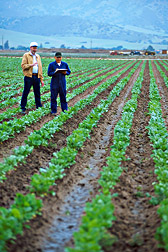This page has been archived and is being provided for reference purposes only. The page is no longer being updated, and therefore, links on the page may be invalid.
Read the magazine story to find out more. |
|
|
Rhizomania Resistance Helps Keep Sugar Beets Safe
By Marcia WoodFebruary 6, 2007
Life can quickly turn from sweet to sour for sugar beets when a killer disease called rhizomania is on the rampage. Big, chunky beets that fall victim to the virus that causes this disease might not be marketable as a source of high-quality sugar—or even of the natural chemicals that could otherwise be used to make bakers' yeast, textiles or printer's ink.
Several years ago, Agricultural Research Service (ARS) plant pathologist Hsing-Yeh Liu was among the first experts to provide needed scientific evidence that a new strain, or isolate, of rhizomania was on the march in some sugar beet fields in southern California. Until that time, the natural resistance that ARS plant geneticists and others had bred into sugar beets had protected the beets against the virus, according to Liu. He's based at the ARS Crop Improvement and Protection Research Unit, Salinas, Calif.
Fortunately, those sugar beet breeders—among them Robert T. Lewellen at Salinas and Leonard W. Panella and co-investigators in Fort Collins, Colo.—had never let down their guard against rhizomania. They now have developed new-generation sugar beets that may hold their own against the new isolate.
|
The scientists expect to make initial supplies of seed from the superior beets available to other sugar beet breeders and seed companies later this year.
These rhizomania-resistant plants fend off not just rhizomania, but at least one other common natural enemy as well, such as microscopic worms known as nematodes.
That's especially good news for those now eyeing sugar beets as a potential biofuel crop. In that role, the humble beet might help reduce America's dependence on foreign oil.
Read more about the research in the February 2007 issue of Agricultural Research magazine.
ARS is the U.S. Department of Agriculture's chief scientific research agency.


